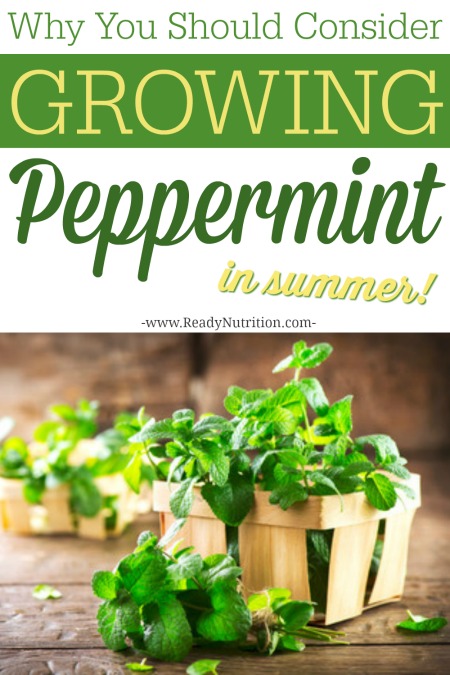As the summer season ramps up and the “fun in the sun” commences, our time spent outside increases. Since we are outside more anyway, why not consider growing a peppermint plant this year? The benefits are numerous!
Originally from Europe, peppermint is now cultivated worldwide for its therapeutic benefits and its flavor. The aromatic plant was created from the blending of watermint and spearmint and is used to add flavor or fragrance to foods, cosmetics, soaps, toothpaste, mouthwashes, and other products, and it may have some medicinal uses. Not to mention it helps keep those pesky mosquitoes away!
Medicinal Properties
Peppermint (Mentha piperita) leaves can be used dried or fresh in teas and it has shown to have some health benefits for irritable bowel syndrome (IBS), nausea, skin conditions, headaches, cold, and flu. Peppermint teas have been a go-to for some time to treat an upset stomach. In fact, loose tea blends, such as Ready Nutrition’s Tummy Tamer Organic Tea Blend is excellent relief for nausea and an upset stomach. Finding a tea with peppermint in it can help you feel better fast, whether you have overindulged, are overwhelmed with stress, or just have a sour stomach.
According to the University of Maryland Medical Center (UMM), peppermint works to soothe stomach distress by calming the stomach muscles and improving the flow of bile. A 2008 study published in the British Medical Journal (BMJ) concluded that peppermint was helpful as an antispasmodic in treating IBS. Antispasmodic properties are those that reduce the intensity and frequency of spasms or involuntary movement.
A team from the University of Adelaide in Australia concluded that peppermint activates an anti-pain channel in the colon, resulting in reduced inflammatory pain in the gut.
Peppermint can also relieve that itchy soreness of a sunburn, Inevitably, no matter how hard I try to avoid it, one member of my family will get a mild to moderate sunburn every summer. Because the menthol in peppermint is naturally cooling, it can be used to take some of the burning and warm sensation out of the sunburn. I like to mix lavender and peppermint into a thin lotion with some aloe vera gel. Not only will your burn feel cooler because of the peppermint, but the lavender will also calm down the redness and the aloe vera gel will help the skin heal and repair itself from the damages done. Be careful with how much peppermint you use. Start small and add more drops to get the desired cooling effect. Sometimes, that cool sensation can be too much, especially for children.
Mosquito Repellent
Because mosquitoes dislike mint in general, peppermint is great at keeping the bloodsuckers away! You can make a simple and natural spray (DEET free!) by filling a small spray bottle almost full with water and add a few drops of peppermint and/or spearmint essential oil, then put in just a little bit of alcohol. You can use vodka or Everclear, but just keep in mind this will separate and you’ll need to shake the bottle before spraying it. The alcohol is used to help the oil and water mix together and will evaporate pretty quickly. Using vinegar or witch hazel in place of the water and alcohol also work if you prefer. Rubbing alcohol is also a good substitute.
And, if you grow your own peppermint, you can make your own essential oil to put in your bug spray!
How To Grow Peppermint
In addition to being an excellent herbal medicine, peppermint is beautiful as and the plants are foolproof to grow! They thrive in both the sun and shade all over North America and can even be grown indoors. In fact, mint can be vigorous spreaders, so be careful where you plant it. To grow the herb outdoors, plant one or two purchased plants (or one or two cuttings from a friend) about 2 feet apart in moist soil. One or two plants will easily cover the ground. Mint should grow to be 1 or 2 feet tall. For the best growth in confined areas such as containers, topdress plants with a thin layer of compost or organic fertilizer every few months. Aboveground pots will need winter protection in cold climates. In the garden, plant mint near cabbage and tomatoes.
Peppermint grows like a weed, so you’ll be able to experiment with making teas, tinctures, lotions, and bug sprays if you do decide to add this useful herb to your garden. I think it’s a must for summer!

This article was originally published at Ready Nutrition™ on July 11th, 2019







